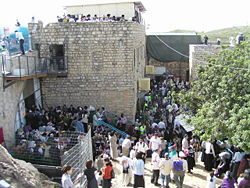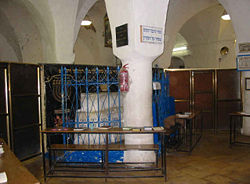Shimon bar Yochai
Rabbi Shimon bar Yohai, (Aramaic: רבן שמעון בר יוחאי) Shimon son of Yohai, Simon son of Yohai or Rashbi (Hebrew: רשב"י, pronounced "Rash-bee," from Rabbi Shimeon bar Yochai.), was a famous rabbi who lived in the era of the Tannaim (scholars of the Mishnah) in the area of what is today Israel during the Roman period, after the destruction of the Second Temple in 70 C.E. He was one of the most eminent disciples of Rabbi Akiva, and is attributed by many with the authorship of the Zohar ("The Brightness"), the chief work of modern-day Jewish mysticism. In addition, the important legal homilies called Sifre and Mekhilta are attributed to him. In the Mishnah, he is often referred to as simply "Rabbi Shimon."
His son, Rabbi Eleazar ben Simon was also a noted scholar.
Critic of Rome
According to the Talmud, Rabbi Shimon bar Yohai criticized the Roman government and was forced to go into hiding with his son for thirteen years. They sheltered in a cave in nearby Peki'in where tradition states that next to the mouth of the cave a carob tree sprang up and a spring of fresh water gushed forth. Provided against hunger and thirst they cast off their clothing except during prayers to keep them from wearing out, embedded themselves in the sand up to their necks, and studied the Torah all day long.[1]
According to historian Heinrich Graetz, Rabbi Shimon's anti-Roman sentiments led to his condemnation by Varna c. 161 C.E. He escaped this doom and dwelt for some years in a cavern. Emerging from concealment, Rabbi Shimon settled in Tiberias and in other Galilean cities.
Works and legends
| Rabbinical Eras |
|---|
He acquired a reputation as a worker of miracles, and on this ground was sent to Rome as an envoy, where (legend tells) he exorcised from the emperor's daughter a demon who had obligingly entered the lady to enable Rabbi Shimon to effect his miracle.
This rabbi bore a large part in the fixation of law, and his decisions are frequently quoted. To him were attributed the important legal homilies called Sifre and Mekhilta, and above all the Zohar, the main work of the Kabbalah.
The fullest account of Rabbi Shimon's teachings is to be found in W Bacher's Agada der Tannaiten, ii. pp. 70-149. When the Talmud attributes a teaching to Rabbi Shimon without specifying which Rabbi Shimon is meant, it means Shimon bar Yochai.
Yahrzeit
Lag Ba'omer is traditionally regarded as his Yahrzeit (the anniversary of the death). Some dispute this.
Unlike other Yahrzeits, this one is widely known as a Yom Hillula, a day of celebration. This is based on the original text of Shaar HaKavanot by Rabbi Moshe Chaim Luzzato, which refers to the day as Yom Simchato ("the day of his happiness"), rather than Yom SheMet ("the day that he died"). There is thus a very widely observed custom to celebrate on his yahrzeit, at Meron, the burial place of Rabbi Shimon bar Yochai and his son, Rabbi Eleazar ben Simon. With torches, song and feasting, the Yom Hillula is celebrated by tens of thousands of people. This celebration was a specific request by Rabbi Shimon bar Yochai of his students. It is a custom at the Meron celebrations, dating from the time of Rabbi Isaac Luria, that three-year-old boys are given their first haircuts (called upshirin), while their parents distribute wine and sweets.
While it is widely accepted that Rabbi Shimon and his son were buried somewhere on Mount Meron, the building generally accepted as being his grave is an arched structure typical of crusader architecture, which is clearly shown in the photo of the building interior.
| Kabbalah Portal |
See also
- Baqashot
- Bar Yohai, a community in northern Israel named after him
Notes
- ↑ Babylonian Talmud, Shabbat, 33b
ReferencesISBN links support NWE through referral fees
External links
- All about Rabbi Shimon Bar Yochai Ohel HaRashbi Meron
- Rabbi Shimon Bar Yochai chabad.org
- Audio Lecture Disputing that Lag Ba'Omer is Rashbi's Yahrzeit on MachonShilo.org
- SIMEON BEN YOḤAI in the Jewish Encyclopedia
| ||||||||||||||||||||||||||||||||||||||||||||||||||||||||||||||||||||||||||||||||||||||||||||||||||||||||||||||||||||||||||||||||||||||||||||||||||||||||||||||||||||||||||||||||||||||||||||||||||||||||||||||||||||||||||||||||||||||||||||||||||||||||||||||||||||||||||||||||||||||||||||||||||||||||||||||||||||||||||||||||||||||||||||||||||||||||||||||||||||||||||||||||||||||||||||||||||||||||||||||||||||||||||||||||||||||||||||||||||||||||||||||||||||||||||||||||||||||||||||||||||||||||||||||||||||||||||||||||||||||||||||||||||||||||||||||||||||||||||||||||||||||||||||||||||
|---|---|---|---|---|---|---|---|---|---|---|---|---|---|---|---|---|---|---|---|---|---|---|---|---|---|---|---|---|---|---|---|---|---|---|---|---|---|---|---|---|---|---|---|---|---|---|---|---|---|---|---|---|---|---|---|---|---|---|---|---|---|---|---|---|---|---|---|---|---|---|---|---|---|---|---|---|---|---|---|---|---|---|---|---|---|---|---|---|---|---|---|---|---|---|---|---|---|---|---|---|---|---|---|---|---|---|---|---|---|---|---|---|---|---|---|---|---|---|---|---|---|---|---|---|---|---|---|---|---|---|---|---|---|---|---|---|---|---|---|---|---|---|---|---|---|---|---|---|---|---|---|---|---|---|---|---|---|---|---|---|---|---|---|---|---|---|---|---|---|---|---|---|---|---|---|---|---|---|---|---|---|---|---|---|---|---|---|---|---|---|---|---|---|---|---|---|---|---|---|---|---|---|---|---|---|---|---|---|---|---|---|---|---|---|---|---|---|---|---|---|---|---|---|---|---|---|---|---|---|---|---|---|---|---|---|---|---|---|---|---|---|---|---|---|---|---|---|---|---|---|---|---|---|---|---|---|---|---|---|---|---|---|---|---|---|---|---|---|---|---|---|---|---|---|---|---|---|---|---|---|---|---|---|---|---|---|---|---|---|---|---|---|---|---|---|---|---|---|---|---|---|---|---|---|---|---|---|---|---|---|---|---|---|---|---|---|---|---|---|---|---|---|---|---|---|---|---|---|---|---|---|---|---|---|---|---|---|---|---|---|---|---|---|---|---|---|---|---|---|---|---|---|---|---|---|---|---|---|---|---|---|---|---|---|---|---|---|---|---|---|---|---|---|---|---|---|---|---|---|---|---|---|---|---|---|---|---|---|---|---|---|---|---|---|---|---|---|---|---|---|---|---|---|---|---|---|---|---|---|---|---|---|---|---|---|---|---|---|---|---|---|---|---|---|---|---|---|---|---|---|---|---|---|---|---|---|---|---|---|---|---|---|---|---|---|---|---|---|---|---|---|---|---|---|---|---|---|---|---|---|---|---|---|---|---|---|---|---|---|---|---|---|---|---|---|---|---|---|---|---|---|---|---|---|---|---|---|---|---|---|---|---|---|---|---|---|---|---|---|---|---|---|---|---|---|---|---|---|---|---|---|---|---|---|---|---|---|---|---|---|---|---|---|---|---|---|---|---|---|---|---|---|---|---|---|---|---|---|---|---|---|---|---|---|---|---|---|---|---|---|---|---|---|---|---|---|---|---|---|---|---|---|---|---|---|---|---|---|---|---|---|---|---|---|---|---|---|---|
| ||||||||||||||||||||||||||||||||||||||||||||||||||||||||||||||||||||||||||||||||||||||||||||||||||||||||||||||||||||||||||||||||||||||||||||||||||||||||||||||||||||||||||||||||||||||||||||||||||||||||||||||||||||||||||||||||||||||||||||||||||||||||||||||||||||||||||||||||||||||||||||||||||||||||||||||||||||||||||||||||||||||||||||||||||||||||||||||||||||||||||||||||||||||||||||||||||||||||||||||||||||||||||||||||||||||||||||||||||||||||||||||||||||||||||||||||||||||||||||||||||||||||||||||||||||||||||||||||||||||||||||||||||||||||||||||||||||||||||||||||||||||||||||||||||
Credits
New World Encyclopedia writers and editors rewrote and completed the Wikipedia article in accordance with New World Encyclopedia standards. This article abides by terms of the Creative Commons CC-by-sa 3.0 License (CC-by-sa), which may be used and disseminated with proper attribution. Credit is due under the terms of this license that can reference both the New World Encyclopedia contributors and the selfless volunteer contributors of the Wikimedia Foundation. To cite this article click here for a list of acceptable citing formats.The history of earlier contributions by wikipedians is accessible to researchers here:
The history of this article since it was imported to New World Encyclopedia:
Note: Some restrictions may apply to use of individual images which are separately licensed.

